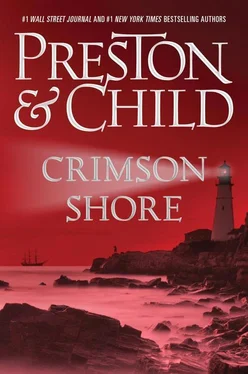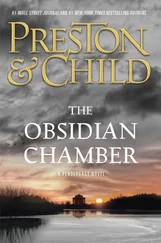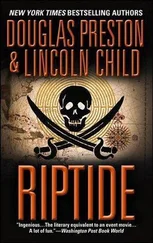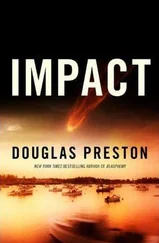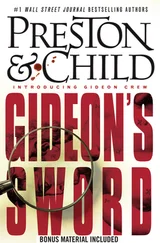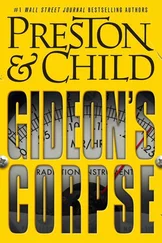Rifles, muskets, pistols, cudgels, and scythes were produced from beneath the greatcoats.
Now a cloak of obscurity fell, and the scene on the beach dissolved. When the dark lifted, Pendergast found himself on the bridge of a vessel: the steamship Pembroke Castle . A man clad in a captain’s uniform stood next to him, staring fixedly with his spyglass at a light onshore. To his right stood the navigator, chart spread out under the dim red glow of a navigational lantern. His tools were laid upon the chart — parallel bars, dividers, pencil. Beside him, the binnacle was only a quarter open, just a gleam emanating from it — the bridge being kept as dark as possible in order for all to maintain their keenest night vision. The helmsman stood to the other side of the captain, wrestling the wheel through the heavy seas.
The air on the bridge was tense, but the captain — through his economical movements and his terse, efficient orders — radiated calm and command. There was no sense of the impending disaster.
In his mind’s eye, retreating into a far corner of the bridge, Pendergast noted that a following sea was bursting over the stern of the ship, black water sweeping fore, the vessel rolling heavily with each swell. A mate came forward, drenched to the skin. In response to the captain’s inquiry, he reported that the steam engines were working efficiently, the oak hull was holding: leaks had been reported, but it was nothing that the bilge pumps couldn’t handle.
Now Captain Libby lowered the spyglass long enough to hear the reports of the first and second mates. The first mate noted that the taffrail log gave the ship’s speed as nine knots; the heading was south-southwest, 190 degrees true. The second mate reported the depth of water, via the drop of the sounding line. “Twelve fathoms,” he cried over the storm. “Shelly bottom.”
Captain Libby did not reply, but his face grew troubled. He raised his glass once again toward what appeared to be the Exmouth Light. “Keep your soundings continuous.” He turned to the navigator. “Keep the light hard a-starboard.”
Pendergast knew enough of maritime navigation to be aware that, because the ship was close to shore and in great danger from the storm, the depth soundings were critically important.
A few minutes later, the second mate returned with another depth report. “Ten fathoms,” he said. “Rocky bottom.”
The captain lowered his spyglass, frowning. “Check again,” he said.
The second mate briefly disappeared again into the storm. “Nine fathoms, rocky bottom.”
All men on the bridge knew that the Pembroke Castle drew three fathoms, or eighteen feet, beneath the waterline. Captain Libby turned to the navigator for an explanation.
“It makes no sense, sir!” the man yelled over the wind. “According to the chart, we should be holding steady at sixteen fathoms, sandy bottom.”
“A rocky bottom means shoaling water,” the captain rapped back. “Either the chart is wrong, or we’re off course.”
The navigator, working behind the pelorus — a kind of dummy compass — took a bearing off the light and then worked furiously with his charts. “It can’t be,” he said, more to himself than to anyone else. “It just can’t be.” He took another bearing off the light.
“Six fathoms,” the voice of the second mate droned. “Rocky bottom.”
The captain stepped over to the pelorus and took his own heading. “Bloody hell,” he said, raising his spyglass again, peering ferociously into the lashing storm, but now nothing was visible — not even the light.
“Hard to port,” the captain abruptly ordered the helmsman in a stentorian voice. “Set new heading 90 degrees true.”
“But Captain,” the first mate protested, “that will put the sea directly on our beam.”
“So be it,” said Libby. “Carry on!” But the helmsman was already swinging the wheel, making the course change, the ship shuddering into a turn.
Even as the Pembroke Castle turned, however, a cry came up from the watch at the bridge wing: “Surf ahead!”
The captain wheeled about, staring through his spyglass. Silently, Pendergast crept up behind. There, ahead, the faintest smudge of white seemed to float on the darkness of the waves.
“Hard right rudder!” Libby roared. “Reverse engines, full astern!”
The order was transmitted to the engine room while the helmsman leapt to obey the wheel order, but the ship was heavy, it was long, and it was fighting a beam sea. The white smudge grew brighter, and a sudden tongue of lightning revealed them for what they were: the Skullcrusher Rocks.
“It’s impossible we’re so far off course!” the navigator cried.
“Full astern!” the captain shouted again, even as the laboring rumble from the engines vibrated the deck. But the crew of the bridge, and Pendergast, could see it was far too late: the horrid rocks loomed up out of the driving rain, surrounded by exploding surf...
...And then there came a shuddering crash as the bow of the ship was thrust violently upward onto the rocks. A massive sea broke over the port rail, bashing through the bridge windows and carrying the first mate and navigator overboard with it.
“Abandon ship!” Captain Libby called out to the second mate. “Crew to stations, lifeboats away, women and children first!”
“Abandon ship! Crew to stations!” The orders went echoing down the line of command as the crew leapt to obey.
Once again the scene dissolved in a second cloak of darkness, Pendergast’s mental point of view returning to the party on the beach. The men were standing, horrified and silent, at the spectacle of the great ship, barely a hundred yards away, as it was thrust up and over the rocks, pounded by the thunderous sea, its back breaking, the stacks coming down, muffled explosions coming from the boilers as seawater rushed in through the breached hull. The violence of the ocean, the distant cries and screams, seemed almost beyond comprehension. The men were struck dumb, aghast at what they had wrought.
There was an effort to lower lifeboats, but the ship was violently careened on the rocks, swung back and forth by the sea, and the effort was almost impossible, the lifeboats bashed to pieces on the rocks or driven into the ship’s hull, spilling their passengers into the sea.
Within minutes, the driving wind and storm surge began carrying wreckage ashore — spars, planks, barrels... and then survivors. A ripple of surprise went through the group standing on the beach. Instead of well-dressed officers, what appeared out of the dark and the storm were young women — some grasping babies or toddlers, still others clinging to debris. They struggled through the surf and onto the beach, crying piteously for help, soaked to the skin, bleeding from scrapes and cuts. Other bodies, already drowned, were washed up the strand and deposited in grotesque, wanton poses. Among them were the bodies of men in dungarees — crew.
Pendergast turned his attention from the wreck to two of the men onshore, so alike they must have been brothers — the one with the stopwatch, the other with the spyglass. Their faces registered confusion and surprise. They clearly had not expected the ship to be laden with so many passengers — especially not women and children. The other men were shocked as well. For a moment, all were paralyzed, unable to act. Then, on impulse, one broke for the water, preparing to help a woman and baby ashore. As he ran past the man with the stopwatch, the leader angrily seized him and threw him to the ground. Then he turned to the others. “These are witnesses!” he cried, addressing the crowd. “Do you understand? Witnesses! Do you all want to swing for this?”
The only answer was the howl of the storm and the piteous sounds of drowning and desperate women and children, struggling up through the surf.
Читать дальше
